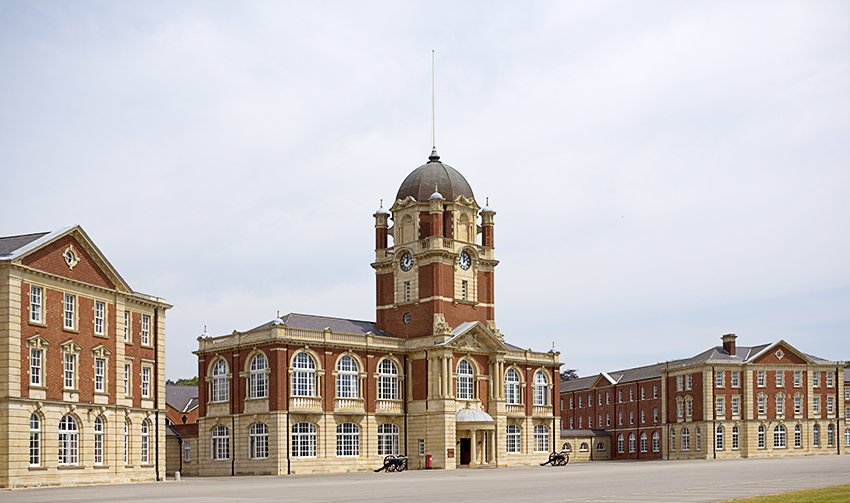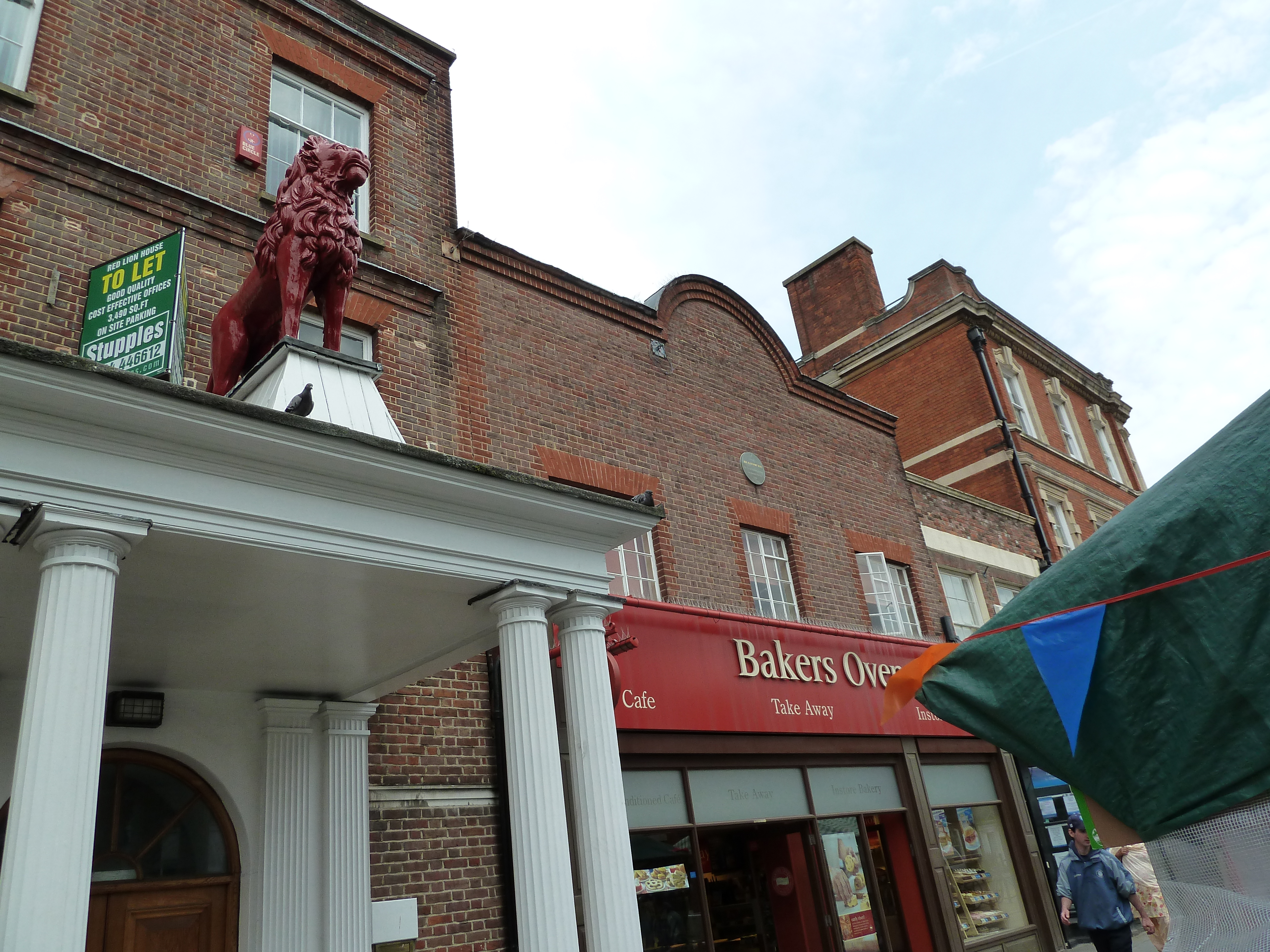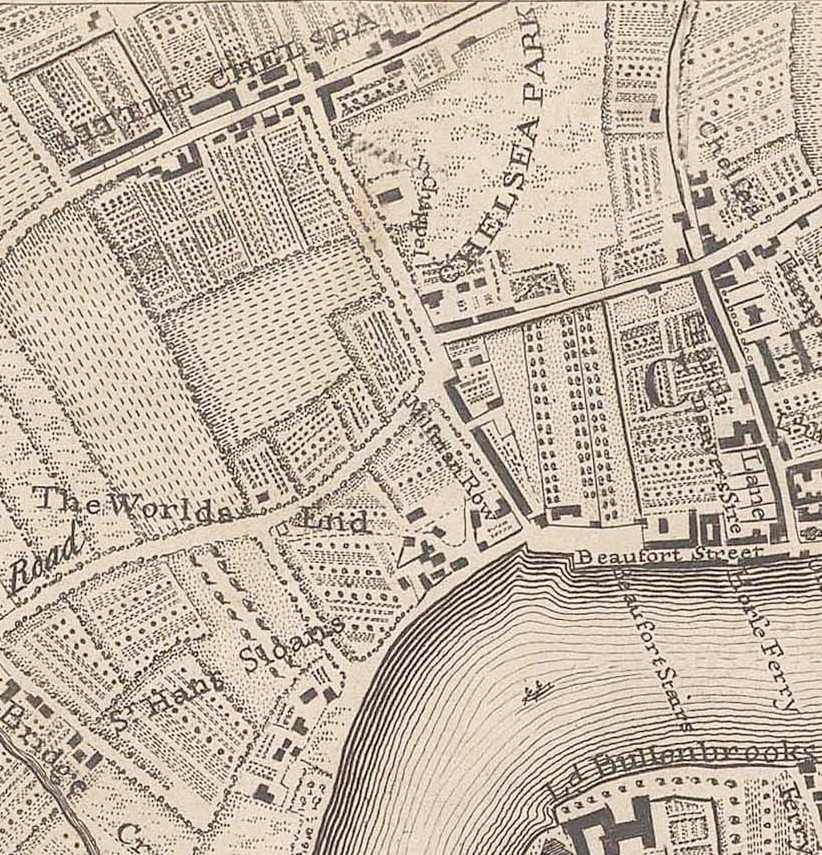|
Royal Military College, Sandhurst
The Royal Military College (RMC), founded in 1801 and established in 1802 at Great Marlow and High Wycombe in Buckinghamshire, England, but moved in October 1812 to Sandhurst, Berkshire, was a British Army military academy for training infantry and cavalry officers of the British and Indian Armies. The RMC was reorganised at the outbreak of the Second World War, but some of its units remained operational at Sandhurst and Aldershot. In 1947, the Royal Military College was merged with the Royal Military Academy, Woolwich, to form the present-day all-purpose Royal Military Academy Sandhurst. History Pre-dating the college, the Royal Military Academy, Woolwich, had been established in 1741 to train artillery and engineer officers, but there was no such provision for training infantry and cavalry officers. The Royal Military College was conceived by Colonel John Le Marchant, whose scheme for establishing schools for the military instruction of officers at High Wycombe and Great M ... [...More Info...] [...Related Items...] OR: [Wikipedia] [Google] [Baidu] |
Sandhurst, Berkshire
Sandhurst is a town and civil parish in the Bracknell Forest borough in Berkshire, England. It is in the south eastern corner of Berkshire, and is situated west-southwest of central London, north west of Camberley and south of Bracknell. Sandhurst is known worldwide as the location of the Royal Military Academy Sandhurst (often referred to simply as "Sandhurst", "The Academy" or "The RMA"). Despite its close proximity to Camberley, Sandhurst is also home to a large and well-known out-of-town mercantile development. The site is named "The Meadows" and has a Tesco Extra hypermarket and a Marks & Spencer, two of the largest in the country. A large Next clothing and homeware store is open on the site of the old Homebase. Geography Sandhurst is in South East England near the junction of Berkshire, Hampshire and Surrey. The town has four main districts, from west to east: Little Sandhurst, Sandhurst (central) and College Town, with Owlsmoor to the northeast. North of the ... [...More Info...] [...Related Items...] OR: [Wikipedia] [Google] [Baidu] |
Royal Military College Great Marlow, 1810
Royal may refer to: People * Royal (name), a list of people with either the surname or given name * A member of a royal family Places United States * Royal, Arkansas, an unincorporated community * Royal, Illinois, a village * Royal, Iowa, a city * Royal, Missouri, an unincorporated community * Royal, Nebraska, a village * Royal, Franklin County, North Carolina, an unincorporated area * Royal, Utah, a ghost town * Royal, West Virginia, an unincorporated community * Royal Gorge, on the Arkansas River in Colorado * Royal Township (other) Elsewhere * Mount Royal, a hill in Montreal, Canada * Royal Canal, Dublin, Ireland * Royal National Park, New South Wales, Australia Arts, entertainment, and media * ''Royal'' (Jesse Royal album), a 2021 reggae album * ''The Royal'', a British medical drama television series * ''The Royal Magazine'', a monthly British literary magazine published between 1898 and 1939 * ''Royal'' (Indian magazine), a men's lifestyle bimonthly * Royal Te ... [...More Info...] [...Related Items...] OR: [Wikipedia] [Google] [Baidu] |
École Spéciale Militaire De Saint-Cyr
The École spéciale militaire de Saint-Cyr (ESM, literally the "Special Military School of Saint-Cyr") is a French military academy, and is often referred to as Saint-Cyr (). It is located in Coëtquidan in Guer, Morbihan, Brittany. Its motto is ''Ils s'instruisent pour vaincre'', literally meaning "They study to vanquish" or, more freely put, "Training for victory". French cadet officers are called ''saint-cyriens'' or ''cyrards''. France's other most senior military education institute is the ''École de guerre'' (EdG) (School of Warfare), located in the ''École militaire'' complex, in Paris. French students who enter Saint-Cyr as cadets are about 21 years old, and undergo three years of training. All ESM cadets graduate with a Master of Arts or a Master of Science and are commissioned officers. The academy was founded in Fontainebleau in 1802 by Napoleon. It was moved in 1806 to the buildings of the former ''Maison Royale de Saint-Louis'', in Saint-Cyr-l'École, west of Pa ... [...More Info...] [...Related Items...] OR: [Wikipedia] [Google] [Baidu] |
French Army
The French Army, officially known as the Land Army (french: Armée de Terre, ), is the land-based and largest component of the French Armed Forces. It is responsible to the Government of France, along with the other components of the Armed Forces. The current Chief of Staff of the French Army (CEMAT) is General , a direct subordinate of the Chief of the Defence Staff (CEMA). General Schill is also responsible to the Ministry of the Armed Forces for organization, preparation, use of forces, as well as planning and programming, equipment and Army future acquisitions. For active service, Army units are placed under the authority of the Chief of the Defence Staff (CEMA), who is responsible to the President of France for planning for, and use of forces. All French soldiers are considered professionals, following the suspension of French military conscription, voted in parliament in 1997 and made effective in 2001. , the French Army employed 118,600 personnel (including the Fo ... [...More Info...] [...Related Items...] OR: [Wikipedia] [Google] [Baidu] |
British India
The provinces of India, earlier presidencies of British India and still earlier, presidency towns, were the administrative divisions of British governance on the Indian subcontinent. Collectively, they have been called British India. In one form or another, they existed between 1612 and 1947, conventionally divided into three historical periods: *Between 1612 and 1757 the East India Company set up Factory (trading post), factories (trading posts) in several locations, mostly in coastal India, with the consent of the Mughal emperors, Maratha Empire or local rulers. Its rivals were the merchant trading companies of Portugal, Denmark, the Netherlands, and France. By the mid-18th century, three ''presidency towns'': Madras, Bombay and Calcutta, had grown in size. *During the period of Company rule in India (1757–1858), the company gradually acquired sovereignty over large parts of India, now called "presidencies". However, it also increasingly came under British government over ... [...More Info...] [...Related Items...] OR: [Wikipedia] [Google] [Baidu] |
Presidency Armies
The presidency armies were the armies of the three presidencies of the East India Company's rule in India, later the forces of the British Crown in India, composed primarily of Indian sepoys. The presidency armies were named after the presidencies: the Bengal Army, the Madras Army and the Bombay Army. Initially, only Europeans served as commissioned or non-commissioned officers. In time, Indian Army units were garrisoned from Peshawar in the north, to Sind in the west, and to Rangoon in the east. The army was engaged in the wars to extend British control in India (the Mysore, Maratha and Sikh wars) and beyond (the Burma, Afghan, First and Second Opium Wars, and the Expedition to Abyssinia). The presidency armies, like the presidencies themselves, belonged to the Company until the Indian Rebellion of 1857, when the Crown took over the Company and its three armies. In 1895, the three presidency armies were merged into a united Indian Army. Origin The origin of the British Indian ... [...More Info...] [...Related Items...] OR: [Wikipedia] [Google] [Baidu] |
Marlow, Buckinghamshire
Marlow (; historically Great Marlow or Chipping Marlow) is a town and civil parish within the Unitary Authority of Buckinghamshire, England. It is located on the River Thames, south-southwest of High Wycombe, west-northwest of Maidenhead and west of central London. Name The name is recorded in 1015 as ''Mere lafan'', meaning "Land left after the draining of a pond" in Old English. From Norman times the manor, parish, and later borough were formally known as Great Marlow, distinguishing them from Little Marlow. The ancient parish was large, including rural areas north and west of the town. In 1896 the civil parish of Great Marlow was divided into Great Marlow Urban District (the town) and Great Marlow civil parish (the rural areas). In 1897 the urban district was renamed Marlow Urban District, and the town has been known simply as Marlow. History Marlow is recorded in the Domesday Book as ''Merlaue''. Magna Britannia includes the following entry for Marlow: "The manor of ... [...More Info...] [...Related Items...] OR: [Wikipedia] [Google] [Baidu] |
Remnantz
Remnantz is a country house in Marlow in Buckinghamshire. It is listed Grade II* on the National Heritage List for England. History The main house was built around 1720 and was occupied by the Royal Military Academy, a facility conceived by Colonel John Le Marchant for training potential junior officers aged 13 to 18, from the Academy's formation in May 1802 until it moved to Sandhurst as the Junior Department of the Royal Military College, in 1811. A stable block, located a short distance south-east of the house, was built around that time. The house was acquired by Thomas Wethered, a brewer, in the first half of the 19th century and it was occupied by Lieutenant Commander Owen Wethered, High Sheriff of Buckinghamshire The High Sheriff of Buckinghamshire, in common with other counties, was originally the King's representative on taxation upholding the law in Anglo-Saxons, Saxon times. The word Sheriff evolved from 'shire-reeve'. High Sheriff, Sheriff is the olde ..., in t ... [...More Info...] [...Related Items...] OR: [Wikipedia] [Google] [Baidu] |
Pound Sterling
Sterling (abbreviation: stg; Other spelling styles, such as STG and Stg, are also seen. ISO code: GBP) is the currency of the United Kingdom and nine of its associated territories. The pound ( sign: ÂŁ) is the main unit of sterling, and the word "pound" is also used to refer to the British currency generally, often qualified in international contexts as the British pound or the pound sterling. Sterling is the world's oldest currency that is still in use and that has been in continuous use since its inception. It is currently the fourth most-traded currency in the foreign exchange market, after the United States dollar, the euro, and the Japanese yen. Together with those three currencies and Renminbi, it forms the basket of currencies which calculate the value of IMF special drawing rights. As of mid-2021, sterling is also the fourth most-held reserve currency in global reserves. The Bank of England is the central bank for sterling, issuing its own banknotes, and ... [...More Info...] [...Related Items...] OR: [Wikipedia] [Google] [Baidu] |
Royal Military College, High Wycombe
The Royal Military College, High Wycombe was a military training facility for British Army officers in High Wycombe in Buckinghamshire. History The college was founded by Colonel John Le Marchant at the Antelope Inn in 1799 as a facility for training junior officers in the British Army who aspired to staff duties. Training was provided in trigonometry, geometry, French language and siege warfare. The facilities proved too small and the institution moved to a building in West Street in Farnham in 1813 before being redesignated the Senior Division of the Royal Military College, Sandhurst in 1820 and then becoming the Staff College, Camberley Staff College, Camberley, Surrey, was a staff college for the British Army and the presidency armies of British India (later merged to form the Indian Army). It had its origins in the Royal Military College, High Wycombe, founded in 1799, which i ... in 1858. References {{authority control Military academies of the United Kingdom ... [...More Info...] [...Related Items...] OR: [Wikipedia] [Google] [Baidu] |
Lewis Lochée
Lewis Lochée (died 8 June 1791) was a military author born in the Austrian Netherlands. From the early 1770s, he was the proprietor and master of a military academy at Little Chelsea, at that time a rural hamlet near Westminster, in Great Britain. After closing his academy in 1790, Lochée returned to the Netherlands to fight for the freedom of the Province of Brabant from the Austrians. In 1791, shortly before his death in France, he published a history of the Revolution. Early life When Lochée was naturalised as a British subject by an Act of Parliament on 8 May 1780, he said he was the son of John and Theresa Lochée, had been born at Brussels in the Province of Brabant, and had "constantly professed the true Protestant Religion"; apart from this, his origins remain obscure.J. E. O. Screen, "The 'Royal Military Academy' of Lewis Lochée" in ''Journal of the Society for Army Historical Research'', Vol. 70, No. 283 (Autumn 1992), pp. 143-156 Life in England In the words of t ... [...More Info...] [...Related Items...] OR: [Wikipedia] [Google] [Baidu] |
Chelsea, London
Chelsea is an affluent area in west London, England, due south-west of Charing Cross by approximately 2.5 miles. It lies on the north bank of the River Thames and for postal purposes is part of the south-western postal area. Chelsea historically formed a manor and parish in the Ossulstone hundred of Middlesex, which became the Metropolitan Borough of Chelsea in 1900. It merged with the Metropolitan Borough of Kensington, forming the Royal Borough of Kensington and Chelsea upon the creation of Greater London in 1965. The exclusivity of Chelsea as a result of its high property prices historically resulted in the coining of the term "Sloane Ranger" in the 1970s to describe some of its residents, and some of those of nearby areas. Chelsea is home to one of the largest communities of Americans living outside the United States, with 6.53% of Chelsea residents having been born in the U.S. History Early history The word ''Chelsea'' (also formerly ''Chelceth'', ''Chelchith' ... [...More Info...] [...Related Items...] OR: [Wikipedia] [Google] [Baidu] |










.jpg)